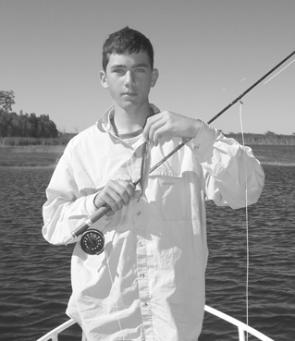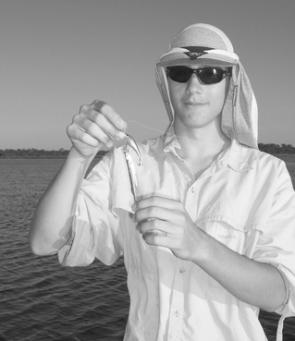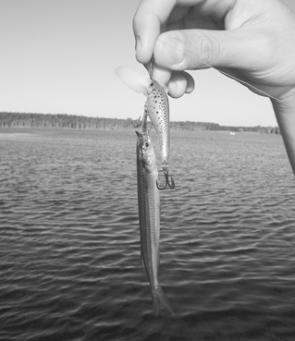While I’ll happily fish for anything with fins, lately I’ve been doing a fair bit of bass fishing.Heading out onto our local lake has made a relaxing change from the hustle and bustle of my usual saltwater trips and I’ve really enjoyed playing with my freshwater lures and trying out some of those trendy bass fishing techniques we’ve all been reading about.
Bass were the primary target for my freshwater forays but another less glamorous species slowly started to get more and more of my attention. That species is the humble snub-nosed garfish, and the more I have to do with these underestimated little battlers, the more I have come to appreciate what a great resource they are.
We caught our first few gar by accident while surface fishing for bass. When we used little poppers we found that the bigger garfish would sometimes try to eat them. Of course, not many gar got hooked because their mouths are pretty small. Occasionally though, when using tiny surface lures like those brilliant little Spaddlers from Predatek, an unlucky gar would manage to impale itself on the trebles and get landed.
This caused quite a few laughs as garfish aren’t normally considered to be lure takers. Unfortunately for them, this habit attracted cruising bass and the garfish went from predator to prey quick smart.
But seeing garfish chase the lure across the top got me thinking. If they are so keen to take a lure off the top, I thought, catching them on fly should be a piece of cake – and it would be a great way to introduce my boys to flyfishing. Snubbies have no teeth or sharp edges to cut lines or careless fingers and, because long casts aren’t required, anyone with even the most basic grasp of flyfishing can enjoy instant success.
Finding the gar is usually pretty easy. Snubbies thrive in the user-friendly surrounds of our freshwater impoundments, and if you do have any trouble finding them, a handful of breadcrumbs will quickly show you if there are any in the area.
My kids had fun catching snub-nosed gar on fly gear and often got more of a kick out of landing a wriggling little gar on the long rod than they did out of catching an average sized bass on their spinning outfits. I figure if my youngsters enjoy it so much, other younger anglers might like to give it a try.
You can use the most basic flyfishing set-up to catch garfish; anything you can catch trout on will be more than a match for even the largest snubby. The boys and I usually use my old 5# Silstar rod with a cheap weight-forward floating line. The leader set-up is extremely basic with around 1m of 6kg for the butt and a 30cm tippet of 2-3kg mono. It’s a nice light outfit which is easy for little arms to cast, and it transmits every tiny kick from those wriggling little garfish.
Once attracted by a bit of bread berley, snubbies will happily take most small flies including nymphs, wet flies and imitation bread flies. My favourite gar fly is actually a small green woolly worm, tied on a light gauge size 10 or 12 hook. It is very ‘buggy’ looking, and the little red tag on the end of the fly seems to really catch their attention. Snubbies are very curious fish and you can exploit this trait to bring them undone. I quickly noticed that if I fished the woolly worm dead drift or with a slow and steady retrieve I got only the odd fish, whereas once I added in some short, sharp strips the fish really got excited.
I saw why this worked so well when I watched what was happening through my Polaroid sunglasses. I was actually teasing the fish into hitting the fly. They would see the fly land and swim over to investigate. If the fly didn’t move, the fish usually lost interest and swam off. If the fly darted away as the fish approached, however, the poor old gar couldn’t help themselves and pounced on the fly and scoffed it down.
Armed with this information, I found that once we had a few fish berleyed up we could almost catch them ‘a fish a cast’. Believe it or not, once you get the hang of it, you can actually catch gar quicker on fly then you can on bait.
In these days of highly pressured fisheries, it’s nice to fish for a species with plentiful numbers, so you don’t have to feel guilty about keeping a few for a feed. Despite being pocket-sized, snubbies are actually quite edible. Half a dozen of the bigger ones make for a fair feed.
Don’t fall into the trap of thinking that gar are too small to bother with – they are definitely not all pencil-sized little wrigglers. We have caught some that pushed 30cm and were so thick you could barely get your thumb and forefinger around them. Most whiting fishermen would be only too happy to catch a fish that size.
And even if you don’t want to eat them, you can still convert them into a good meal of fresh fillets if you keep a few for saltwater troll baits.
If you really want to know how big the bass in your local impoundment grow, put a live gar back out and hang on. But, being a keen lure angler, I wouldn’t know anything about that of course…
Reads: 3564
When you are nine years old, any fish on fly is a great achievement. Matthew Magner now loves chasing gar on the old man’s fly rod.

The author’s eldest son James, with his first fly-caught fish. An important milestone in any young angler’s career.

Garfish are incredibly curious and you can use this trait to bring them undone. Any small lure worked across the top draws them like a magnet.

Who says garfish don’t eat lures? This little snubby tried to make a meal out of this Predatek Spaddler.




